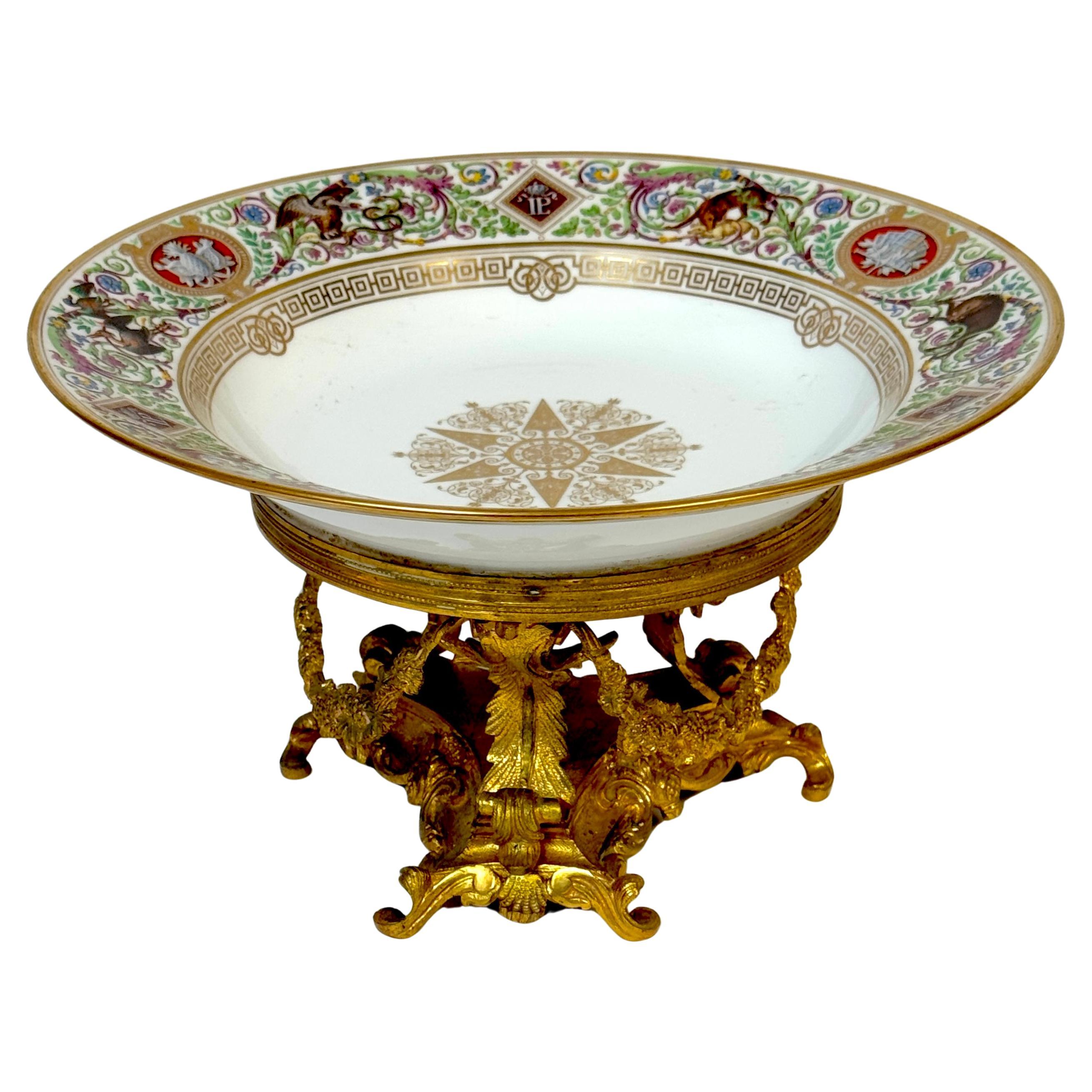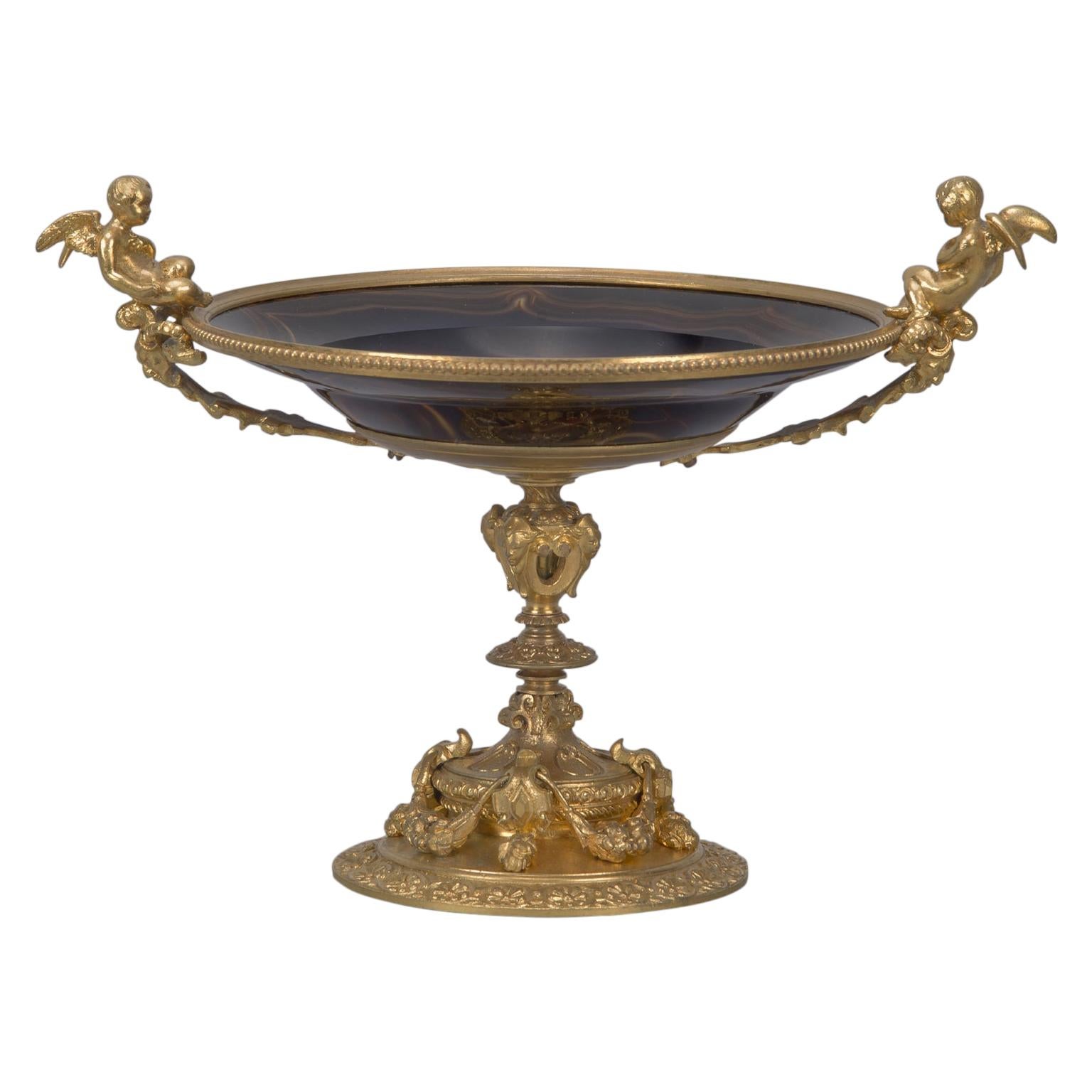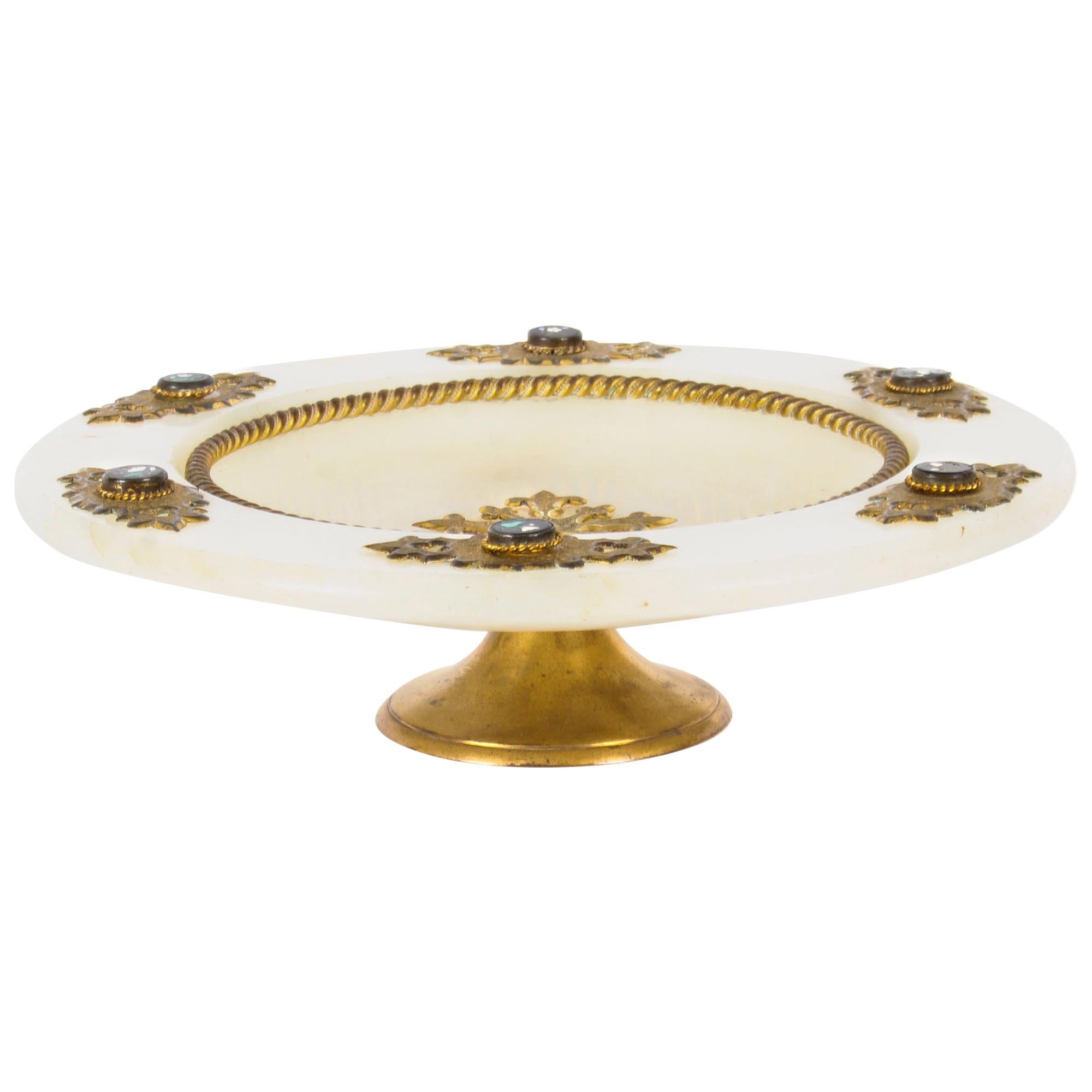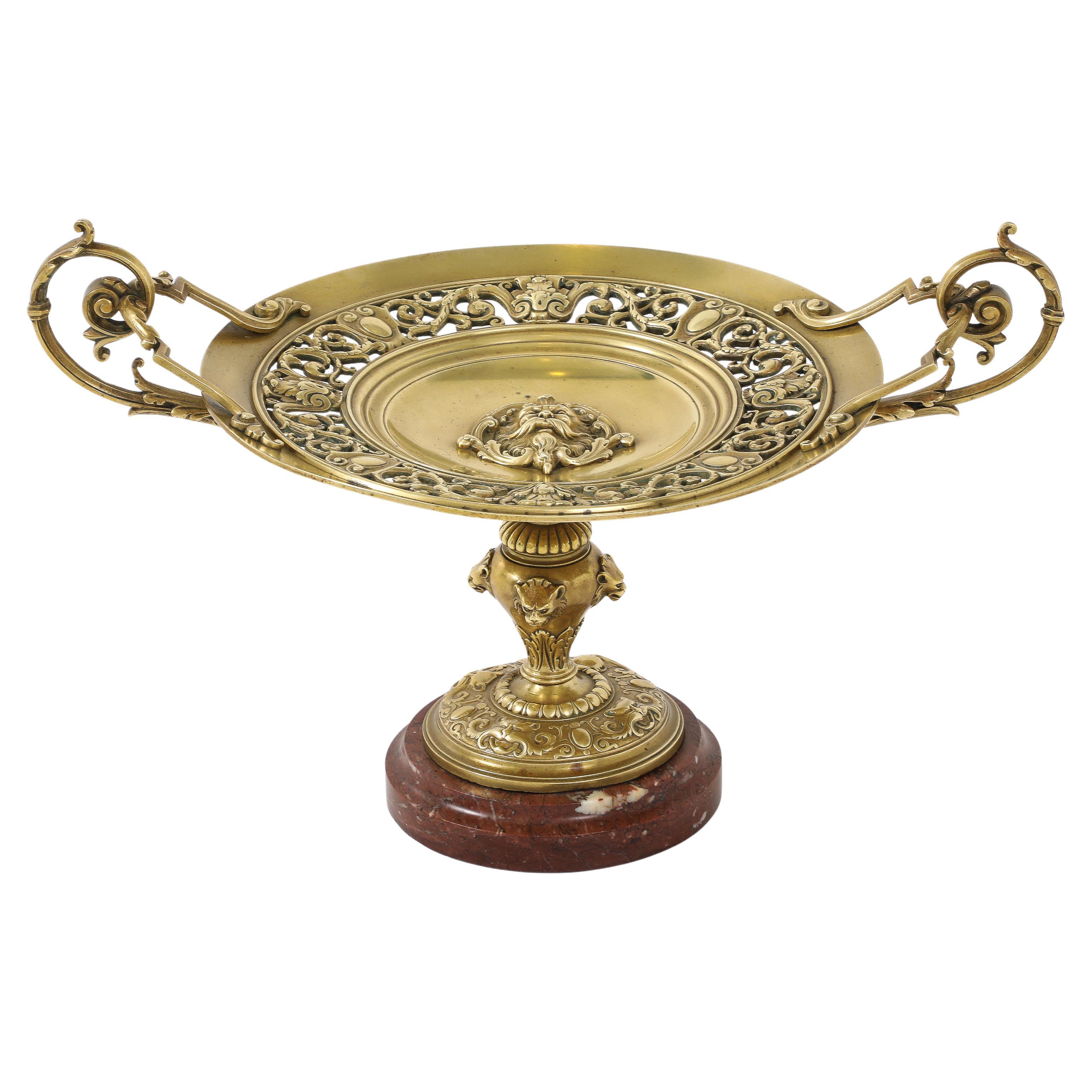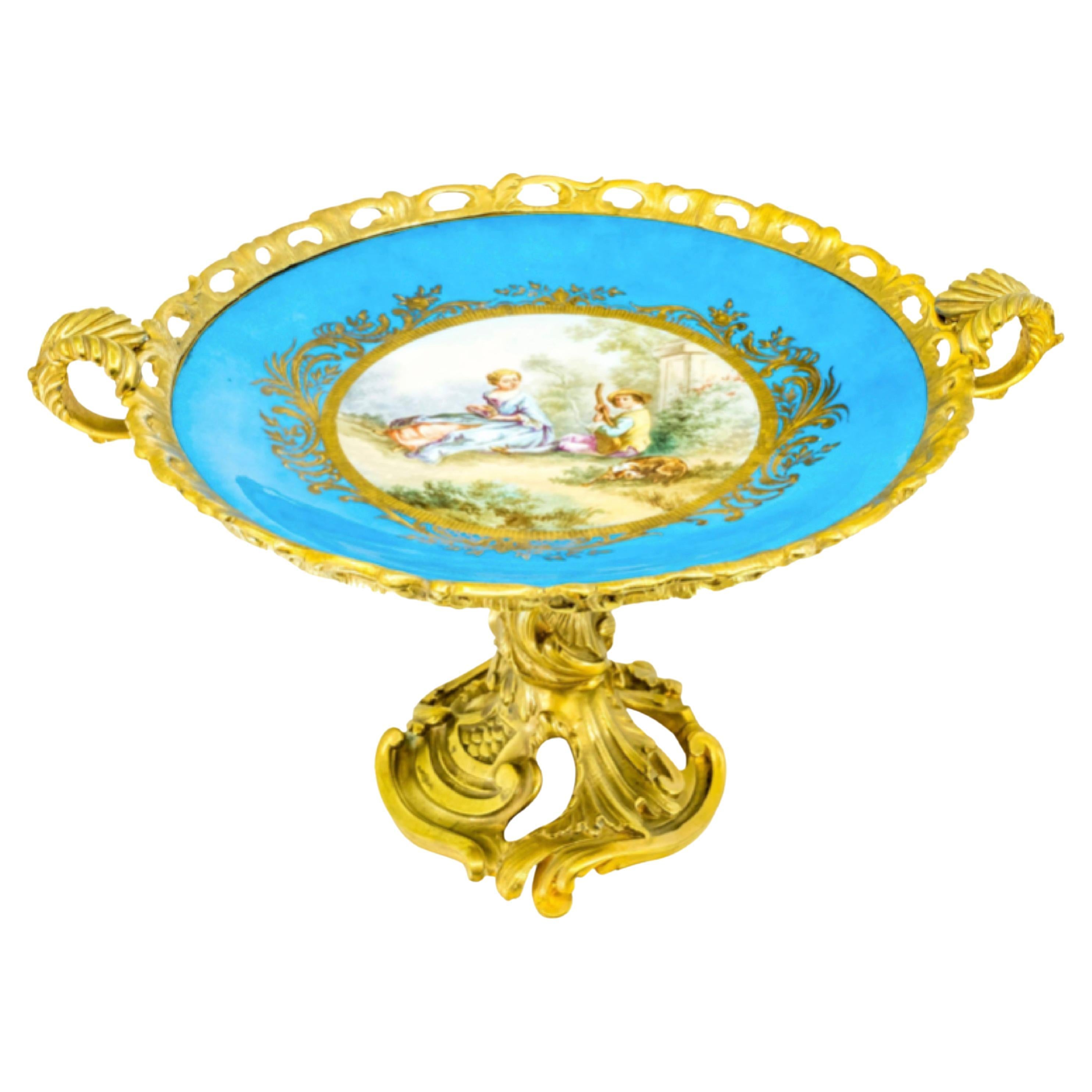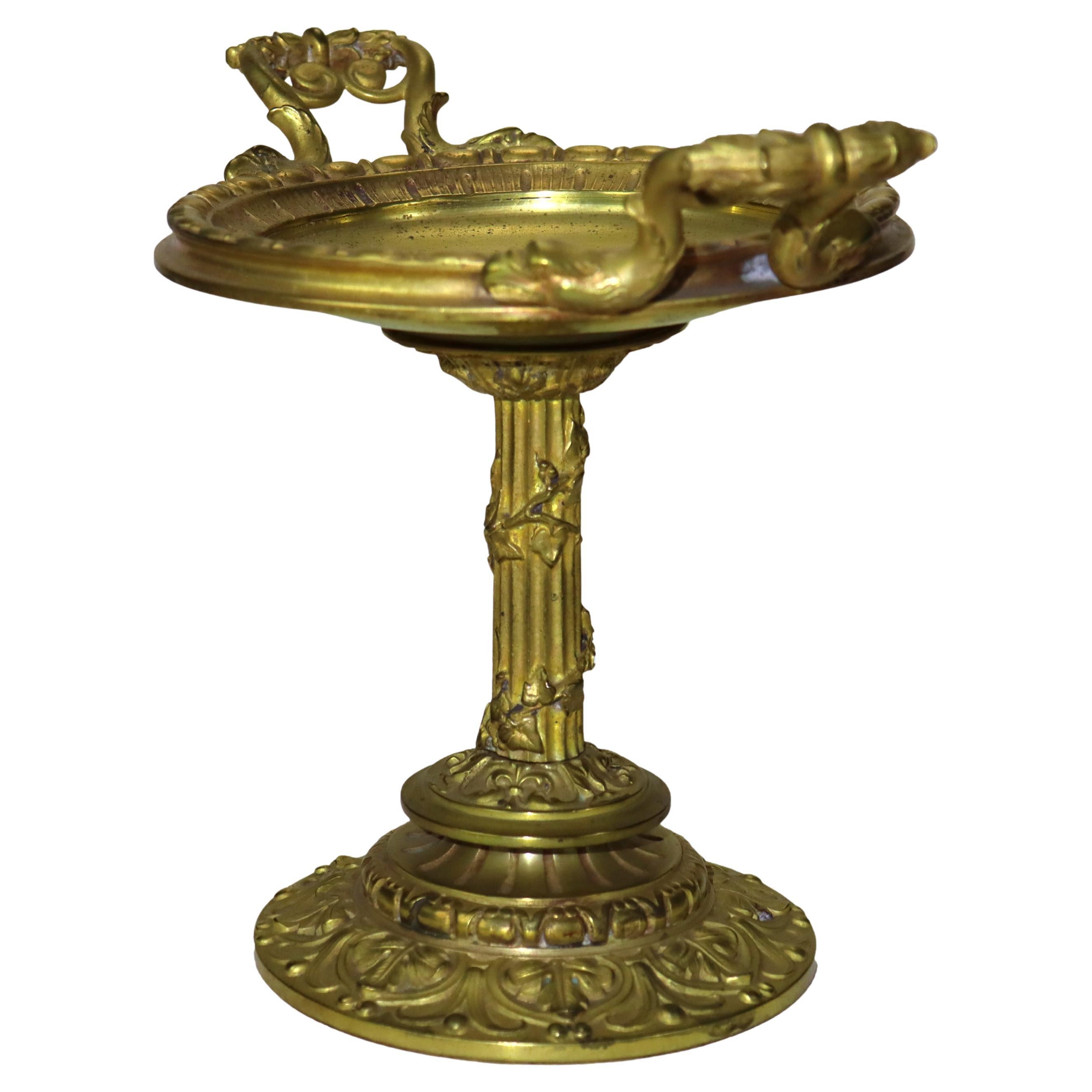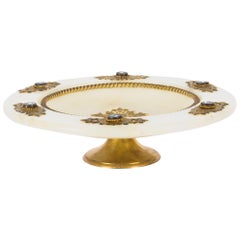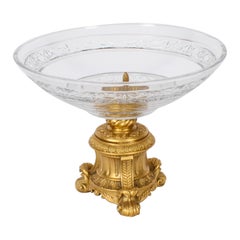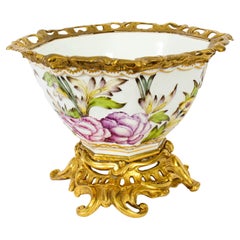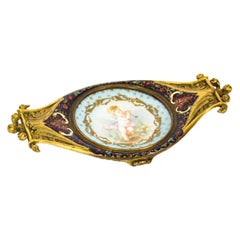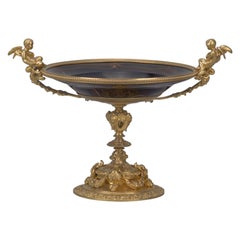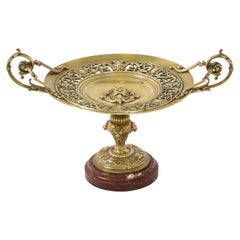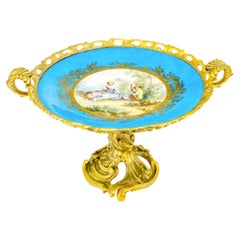Items Similar to Antique French Ormolu Tazza with Limoges Enamel Plaque, 19th Century
Video Loading
Want more images or videos?
Request additional images or videos from the seller
1 of 15
Antique French Ormolu Tazza with Limoges Enamel Plaque, 19th Century
$1,721.89
£1,250
€1,473.52
CA$2,367.85
A$2,633.28
CHF 1,378.40
MX$32,122.82
NOK 17,320.11
SEK 16,291.80
DKK 10,998.89
About the Item
This is an impressive and highly decorative French ormolu tazza, mid-19th century in date.
It features twin handles to either side and the centre is inset with a beautiful Limoges enamel plaque depicting a lady in Renaissance clothing. It is raised on four scrolling supports on a Carrara marble base with a central ormolu rosette and an ormolu underside.
Condition:
In reallyexcellent condition having been beautifully cleaned in our workshops, please see photos for confirmation.
Dimensions in cm:
Height 25 x width 34 x depth 28
Dimensions in inches:
Height 9.8 x width 13.4 x depth 11.0
Limoges enamel
has been produced at Limoges, in south-western France, over several centuries up to the present.
Ormolu - (from French 'or moulu', signifying ground or pounded gold) is an 18th century English term for applying finely ground, high-carat gold in a mercury amalgam to an object of bronze.The mercury is driven off in a kiln leaving behind a gold-coloured veneer known as 'gilt bronze'.
The manufacture of true ormolu employs a process known as mercury-gilding or fire-gilding, in which a solution of nitrate of mercury is applied to a piece of copper, brass, or bronze, followed by the application of an amalgam of gold and mercury. The item was then exposed to extreme heat until the mercury burned off and the gold remained, adhered to the metal object.
After circa 1830 because legislation had outlawed the use of mercury other techniques were used instead. Electroplating is the most common modern technique. Ormolu techniques are essentially the same as those used on silver, to produce silver-gilt..
About the Seller
5.0
Platinum Seller
Premium sellers with a 4.7+ rating and 24-hour response times
Established in 1983
1stDibs seller since 2012
1,386 sales on 1stDibs
Typical response time: <1 hour
Associations
LAPADA - The Association of Arts & Antiques Dealers
- ShippingRetrieving quote...Shipping from: London, United Kingdom
- Return Policy
Authenticity Guarantee
In the unlikely event there’s an issue with an item’s authenticity, contact us within 1 year for a full refund. DetailsMoney-Back Guarantee
If your item is not as described, is damaged in transit, or does not arrive, contact us within 7 days for a full refund. Details24-Hour Cancellation
You have a 24-hour grace period in which to reconsider your purchase, with no questions asked.Vetted Professional Sellers
Our world-class sellers must adhere to strict standards for service and quality, maintaining the integrity of our listings.Price-Match Guarantee
If you find that a seller listed the same item for a lower price elsewhere, we’ll match it.Trusted Global Delivery
Our best-in-class carrier network provides specialized shipping options worldwide, including custom delivery.More From This Seller
View AllItalian Pietra Dura Mounted Brass and Alabaster Comport Dish, 19th Century
Located in London, GB
This is a superb quality antique Italian Pietra Dura mounted, gilt brass and alabaster table-centre comport dish, dating from the late 19th century.
With striking pierced Neo-Gothic chased brass mounts this splendid alabaster dish is set with six highly decorative pietra dura roundels depicting various floral decoration.
It is raised on a sturdy circular brass base.
It is a sumptuous piece which will make a great statement in any special room.
Condition:
In really excellent condition, please see photos for confirmation.
Dimensions in cm:
Height 8 x width 29 x depth 29
Dimensions in inches:
Height 3.1 x width 11.4 x depth 11.4
Pietra Dura is a term for the inlay technique of using cut and fitted, highly polished colored stones to create images. It is considered a decorative art.
Pietre dure is an Italian plural meaning "hard rocks" or hardstones; the singular pietra dura is also encountered in Italian. In Italian, but not in English, the term embraces all gem engraving and hardstone carving, which is the artistic carving of three-dimensional objects in semi-precious stone, normally from a single piece, for example in Chinese jade.
The traditional convention in English has been to use the singular pietra dura just to denote multi-colored inlay work. However, in recent years there has been a trend to use pietre dure as a term for the same thing, but not for all of the techniques it covers, in Italian.
But the title of a 2008 exhibition at the Metropolitan Museum of Art, New York, Art of the Royal Court: Treasures in Pietre Dure from the Palaces of Europe used the full Italian sense of the term, probably because they thought that it had greater brand recognition. The material on the website speaks of objects such as a vase in lapis lazuli as being examples of "hardstone carving (pietre dure)"
The Victoria & Albert Museum in London uses both versions on its website, but uses pietra dura. "A method of inlaying colored marbles or semi-precious stones into a stone base, often in geometric or flower patterns...."
Giovanni Montelatici...
Category
Antique 1890s Italian More Dining and Entertaining
Materials
Alabaster, Brass
Vintage Ornate Cut Glass & Ormolu Centrepiece Dish 20th Century
Located in London, GB
A beautiful vintage cut glass and ormolu dish that would make a stunning centrepiece, late 20th Century in date.
The craftsmanship is second to none throughout all aspects of this ...
Category
1990s English Glass
Materials
Ormolu
Antique Gilt Bronze & Samson Porcelain Centrepiece, 19th Century
Located in London, GB
This is a fine antique French Samson porcelain centrepiece, Circa 1860 in date.
The octagonal shaped centrepiece features a colourful relief body decorated with flower sprays and...
Category
Antique 1860s French Porcelain
Materials
Ormolu
Antique French Ormolu and Champlevé Enamel Pin Tray, 19th Century
Located in London, GB
A really beautiful French ormolu, champlevé enamel and Sèvres Porcelain pin tray, circa 1880 in date.
The ormolu and champleve border is set with a charming hand painted winged ch...
Category
Antique 1880s French Porcelain
Materials
Enamel, Ormolu
Antique French "Japonesque" Porcelain dish by Louis Pierre Malpass 19th C
Located in London, GB
This is an absolutely fabulous antique French "Japonesque" ormolu mounted porcelain tripod dish, late 19th century in date.
It bears the signature of Louis-Pierre Malpass, one of th...
Category
Antique 1890s French Porcelain
Materials
Ormolu
Antique Silver Plated and Engraved Glass Comport Centrepiece, 19th Century
Located in London, GB
This is a fabulous antique English silver-plated and engraved glass table centre comport, dated with the registration lozenge for 10th September 1...
Category
Antique 1850s English Sheffield and Silverplate
Materials
Silver Plate
You May Also Like
Sevres Porcelain Ormolu Tazza, 1838 Hunting Royal Service of King Louis Philippe
By Manufacture Nationale de Sèvres
Located in West Palm Beach, FL
Sevres Porcelain Ormolu Tazza, 1838 Hunting Royal Service of King Louis Philippe
This exceptional Sèvres porcelain ormolu-mounted tazza, dating to 1838, forms part of the renowned ...
Category
Antique 19th Century French Louis Philippe Porcelain
Materials
Ormolu
Napoleon III Gilt-Bronze and Agate Glass Tazza, French, circa 1870
Located in Brighton, West Sussex
A Napoleon III gilt bronze and agate glass tazza.
French, circa 1870.
Category
Antique Mid-19th Century French Napoleon III Decorative Dishes and Vide-...
Materials
Bronze
Grand Tour French Bronze Tazza With Rose Marble Base
Located in New York, NY
Amazing 19th century French bronze tazza with rose marble base, in vintage original condition with some wear and patina due to age and use, there is some wear to the marble and minor...
Category
Antique 1890s French Mid-Century Modern Decorative Bowls
Materials
Carrara Marble, Bronze
French Sèvres-style Porcelain Plate in Gilt Bronze Mount
By Manufacture Nationale de Sèvres
Located in Lantau, HK
This French Sèvres-style porcelain plate from the 19th century is set in a gilt bronze mount, ormolu that features a Rococo base, rim and two handles with stylized foliage and C-scro...
Category
Antique 19th Century French Rococo Centerpieces
Materials
Porcelain
Antique Gilt Bronze Tazza With Fluted Column C1880
Located in Big Flats, NY
Antique Gilt Bronze Tazza With Fluted Column C1880
Measures - 10" x 12 1/4" x 7 7/8".
A finely crafted antique gilt bronze tazza from circa 1880, featuring an elegant fluted col...
Category
Antique Late 19th Century Serving Pieces
Materials
Bronze
$760 Sale Price
20% Off
19th Century Small Dish Hand Painted Enamel and Ormolu Bronze
Located in Casteren, Noord-Brabant
An elegant small footed dish.
Made of gilded bronze with an enameled, hand painted dish in the centre.
The dish is in good condition.
Dimensions: 17 x 9 cm and 9 cm tall.
Made in Fra...
Category
Antique 1890s French Napoleon III Decorative Dishes and Vide-Poche
Materials
Bronze, Enamel
More Ways To Browse
Renaissance Plaque
French Enamel On Copper
Antique Outlaws
Limoges Plaques
Copper Enamel Plaque
Limoges Enamel Plaque
Limoge Enamel Copper Plaque
Ladle Gravy
Ice Chest
Jelly Glass
Table Placemats
Sterling Demitasse Spoons Set
Vintage Ice Tea Glasses
Vintage Dinner Knife
Mid Century Salad Servers
Rare Knives
Vintage Stainless Flatware Patterns
Cheese Knives
